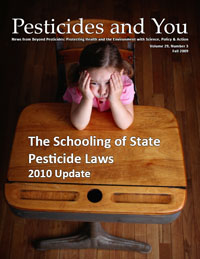Children, Pesticides and Schools: School Environment Protection Act of 2012

National legislation is needed to protect children from toxic pesticides used in and around schools. The School Environment Protection Act (SEPA), HR 4225 was introduced on March 20, 2012, in a previous session of Congress, but was not enacted.
Quick Links
- Action Alert: Ask your Member of Congress to support SEPA
- Show your support for SEPA on POPVOX, a website that provides public opinion to Congress.
- SEPA factsheet
- SEPA text
In the report, The Schooling of State Pesticide Laws – 2010 Update, Beyond Pesticides finds that 21 states recommend or require schools to use IPM, a 24 percent increase since the original report was written in 1998. While this growth is occurring and other measures are being taken to provide written notice prior to pesticide use (24 states, a 30 percent increase), the majority of school children continue to be exposed to toxic pesticides while at school. Beyond Pesticides finds that only 35 states have taken limited action to step in and provide protective measures to address pesticide use in, around or near their schools.
However, these laws represent a patchwork of laws that are uneven and inadequate. SEPA would provide a minimum national standard. Shouldn't all children and staff have a basic level of protection from hazardous pesticide exposure?
- SEPA requires that all public schools adopt integrated pest management (IPM) programs indoors that emphasize non-chemical pest management strategies and only use defined least-toxic pesticides as a last resort.
- Requires organic management of school grounds and playing fields, and prohibits synthetic fertilizers due to their adverse impact on healthy soils, plants, and turf, and associated environmental impacts.
- Least-toxic pesticides do not include: pesticides that are carcinogens, reproductive and developmental toxicants, nervous and immune system poisons, endocrine disruptors, or have data gaps or missing information on health effects, as well as outdoor pesticides that adversely affect wildlife, have high soil mobility, or are groundwater contaminants.
- The bill establishes a 12-member National School IPM Advisory Board that, with the help of a technical advisory panel, will develop school IPM standards and a list of allowable least-toxic pesticide products.
- It requires each state to develop its IPM plan as part of its existing state cooperative agreement with the U.S. EPA.
- A public health emergency provision allows the use of a pesticide, if warranted. In this case, notification of the pesticide application is required to be provided to all parents and guardians of students and school staff.
- Cleaning agents with pesticides fall under the bill’s purview.
Why Federal Legislation Is Needed
- A 2005 study published in the Journal of American Medical Association finds that students and school employees are being poisoned by pesticide use at schools and from drift off of neighboring farmlands; the study authors noted the lack of protection for school children and employees under federal law, pointing out that state laws provide some protection but are varied, thus leaving large gaps;
- A 1999 U.S. GAO report found that EPA is not doing enough to protect children from pesticides;
- The Poison Control Center has documented 2,300 school pesticide exposures from 1993-96;
- Although the U.S. EPA and several states recommend safer school pest management practices and pesticide use notification, and there is a fair amount of good will among school administrators, custodians, pest management professions, only 26% of schools are following those recommendations and therefore, recommendations prove to be largely ineffective (according to Are Schools Making the Grade;
- Children are among the least protected population group when it comes to pesticide exposure; and,
- There are numerous deficiencies in the existing regulatory review of pesticides, such as:
- Reregistration is an ongoing process with outstanding and missing data;
- FIFRA and FQPA risk standards by definition allow levels of risk or harm to be set;
- Inerts are not fully evaluated;
- Active ingredients are rarely tested in combination with other ingredients;
- Pesticide ingredients can breakdown to more toxic chemicals; and,
- We have little knowledge or control of many exposure scenarios, making determination of risk and hazards more complex.
There are numerous benefits to such legislation. SEPA would:
- Halt students and staff from unknowingly being exposed to the unnecessary use of hazardous pesticides;
- Force school administrators to know about their schools' pest management practices;
- Require schools to move to safer, more effective pest management;
- Allow parents, school nurses, and staff to find out what is being applied and take any necessary precautions;
- Help the dissemination of existing manuals, guides, etc. on implementing safer practices;
- Decrease the cost schools would spend on pest management;
- Allow states and localities the authority to adopt standards regarding implementation of the law as they see fit;
- Lead to a healthier school environments; and,
- Ensure longevity of safer school pest management programs.
Children's Special Vulnerability to Pesticides
The vulnerability of infants and children to the harmful effects of pesticides has attracted national attention over the years. EPA and the National Academy of Sciences, among others, have voiced concerns about the danger that pesticides pose to children, even at low levels. Children face higher risks than adults from pesticide exposure due to their small size, tendency to place their hands close to their face, engaging in activities on or near the ground, greater intake of air and food relative to body weight, developing organ systems, and other unique characteristics.
School is a place where children need a healthy body and a clear head in order to learn. Numerous scientific studies find that pesticides typically used in schools are linked to chronic health effects such as cancer, asthma, neurological and immune system diseases, reproductive problems, and developmental and learning disabilities. IPM in schools has proven to be an effective and economical method of pest management that can prevent pest problems and eliminate the use of hazardous pesticides in school buildings and on school grounds.
Adverse health effects, such as nausea, dizziness, respiratory problems, headaches, rashes, and mental disorientation, may appear even when a pesticide is applied according to label directions. Pesticide exposure can adversely affect a child's neurological, respiratory, immune, and endocrine system and have been shown to cause or exacerbate asthma symptoms. Studies show that children living in households where pesticides are used suffer elevated rates of leukemia, brain cancer, and soft tissue sarcoma. Because most of the symptoms of pesticide exposure, from respiratory distress to difficulty in concentration, are common in school children and may also have other causes, pesticide-related illnesses often go unrecognized and unreported.
Previous Efforts to Pass SEPA
SEPA was first introduced in November 1999 in both the U.S. Senate and House; and has been reintroduced every Congressional session since. The bill language is based on state school pest management laws. It also mirrored the structure of the Organic Foods Production Act of 1990, which established a national committee to oversee the program as well as established a list of pesticides allowed for use within the program. A form of SEPA has passed the U.S. Senate twice since and, together with other legislation, indicates broad support for a national mandate to stop hazardous pesticide use in schools.
Additional Resources
- The 40 Most Commonly Used Pesticides in Schools
- Children and Pesticides Don't Mix
- Asthma, Children and Pesticides
- The School Environment Protection Act: Myths and Facts
- Schools Save Money with Integrated Pest Management
- Safer Schools: Achieving a Healthy Learning Environment Through Integrated Pest Management
- Select Studies on Pesticides and Children's Health
- Latest News on Children/Schools and Pesticides
For more information contact Beyond Pesticides at 202-543-5450 or [email protected].
.








